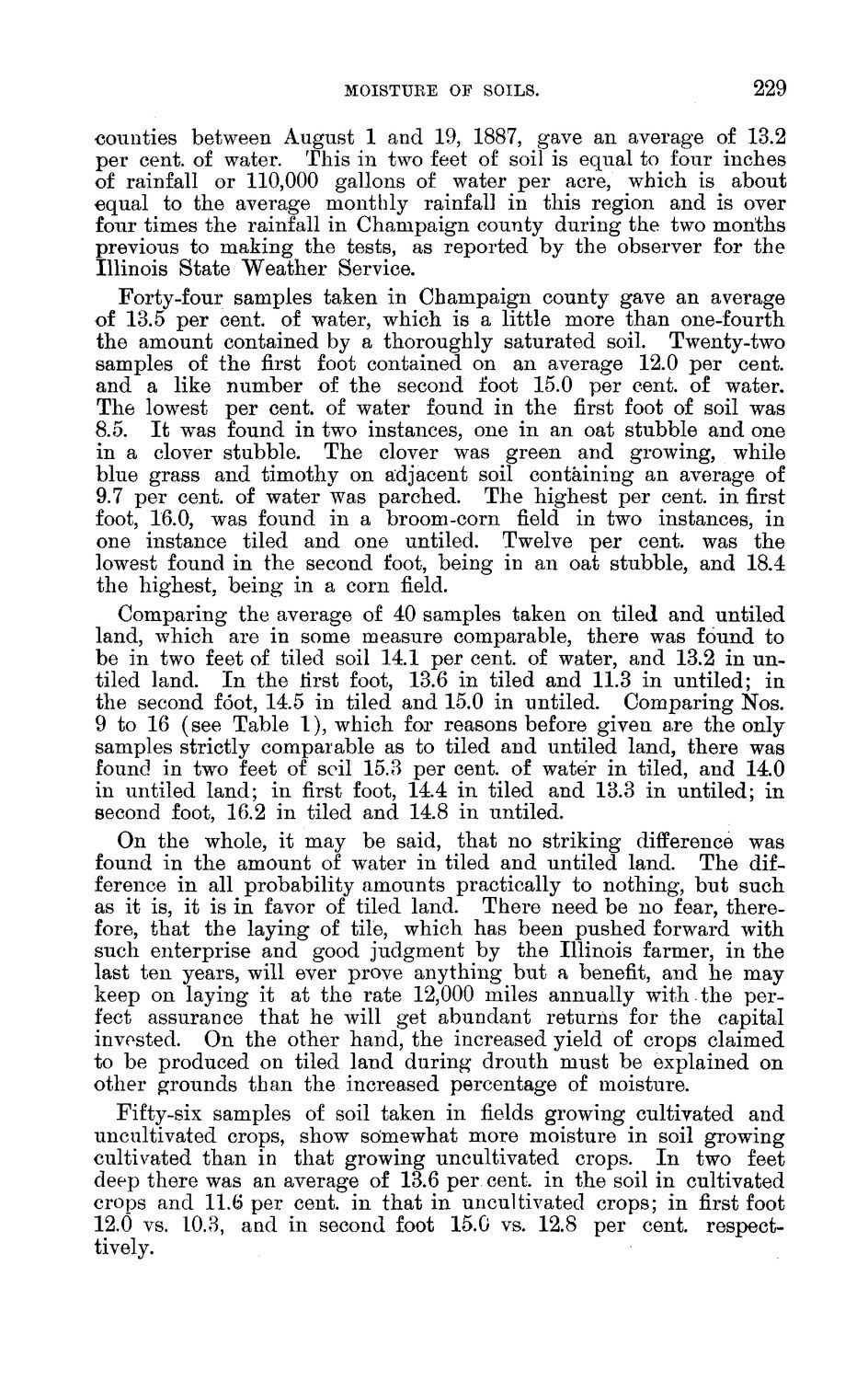| |
| |
Caption: Board of Trustees Minutes - 1888
This is a reduced-resolution page image for fast online browsing.

EXTRACTED TEXT FROM PAGE:
MOISTURE OF SOILS. 229 counties between August 1 and 19, 1887, gave an average of 13.2 per cent, of water. This in two feet of soil is equal to four inches of rainfall or 110,000 gallons of water per acre, which is about equal to the average monthly rainfall in this region and is over four times the rainfall in Champaign county during the two months previous to making the tests, as reported by the observer for the Illinois State Weather Service. Forty-four samples taken in Champaign county gave an average of 13.5 per cent, of water, which is a little more than one-fourth the amount contained by a thoroughly saturated soil. Twenty-two samples of the first foot contained on an average 12.0 per cent, and a like number of the second foot 15.0 per cent, of water. The lowest per cent, of water found in the first foot of soil was 8.5. I t was found in two instances, one in an oat stubble and one in a clover stubble. The clover was green and growing, while blue grass and timothy on adjacent soil containing an average of 9.7 per cent, of water was parched. The highest per cent, in first foot, 16.0, was found in a broom-corn field in two instances, in one instance tiled and one untiled. Twelve per cent, was the lowest found in the second foot, being in an oat stubble, and 18.4 the highest, being in a corn field. Comparing the average of 40 samples taken on tiled and untiled land, which are in some measure comparable, there was found to be in two feet of tiled soil 14.1 per cent, of water, and 13.2 in untiled land. In the first foot, 13.6 in tiled and 11.3 in untiled; in the second foot, 14.5 in tiled and 15.0 in untiled. Comparing Nos. 9 to 16 (see Table 1), which for reasons before given are the only samples strictly comparable as to tiled and untiled land, there was found in two feet of soil 15.3 per cent, of water in tiled, and 14.0 in untiled land; in first foot, 14.4 in tiled and 13.3 in untiled; in second foot, 16.2 in tiled and 14.8 in untiled. On the whole, it may be said, that no striking difference was found in the amount of water in tiled and untiled land. The difference in all probability amounts practically to nothing, but such as it is, it is in favor of tiled land. There need be no fear, therefore, that the laying of tile, which has been pushed forward with such enterprise and good judgment by the Illinois farmer, in the last ten years, will ever prove anything but a benefit, and he may keep on laying it at the rate 12,000 miles annually wTith the perfect assurance that he will get abundant returns for the capital invested. On the other hand, the increased yield of crops claimed to be produced on tiled land during drouth must be explained on other grounds than the increased percentage of moisture. Fifty-six samples of soil taken in fields growing cultivated and uncultivated crops, show somewhat more moisture in soil growing cultivated than in that growing uncultivated crops. I n two feet deep there was an average of 13.6 per cent, in the soil in cultivated crops and 11.6 per cent, in that in uncultivated crops; in first foot 12.0 vs. 10.3, and in second foot 15.0 vs. 12.8 per cent, r e s p e c tively.
| |